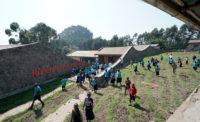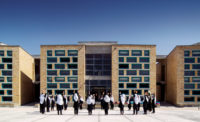Ilima, Democratic Republic of Congo
MASS Design group is used to working in remote places. Building schools or health centers where there were none and training local labor is practically written into its DNA. Michael Murphy and Alan Ricks founded the Boston-based nonprofit architecture firm in 2010 during the design and construction of the Butaro District Hospital, the first of its kind in the rural Burera district of northern Rwanda.
The Ilima Primary School, in a Congolese jungle village, is remote to an extreme even for MASS. In 2013, MASS was approached by the African Wildlife Foundation (AWF) to design and build the school as part of the organization’s efforts in the continent’s most environmentally vulnerable places. AWF offers an unusual barter: it will provide a “conservation school” if a community promises to protect thousands of acres of rain forest from hunting, logging, and agriculture. In the case of the village of Ilima, it’s more than 600,000 acres.
“The first thing we ask about a new project is, ‘What impact will it have? Will the community embrace it?’ ” says Murphy. The answers were clearly positive in the case of Ilima. Deforestation and poaching of endangered species such as bonobo apes have global implications, as well as local ones. These problems stem, in part, from poverty and lack of access to education. “We know that one school will not solve all of that, but we can ask if our investments in primary infrastructure are a step in the right direction in stabilizing the most vulnerable,” says Murphy.
Andrew Brose, a MASS project director based in Kigali, Rwanda, moved to Ilima for a year with his wife, Rachel Brose, to lead the construction. Working with two Congolese interns, Jeancy Mulela and Jonathan Bongi, the team overcame challenges “maximized to the power of 10,” as Brose put it. Sited along the village’s main road, the one-story building also serves as a community center—it’s the largest and most complex structure many of the villagers have ever seen. “Because we were working with unskilled labor, to get the idea across through drawings and descriptions wasn’t adequate,” says Brose. “It wasn’t until the building took shape that it was clear what the goal was.”
For the design, the architects staked out two circles, one for a demonstration and conservation garden, the other for a play area. The school—two arcs that face away from each other—sits between the two circles and has a laterite and compacted-soil foundation. The southern arc contains three classrooms and a library; the northern arc houses three classrooms and an administration space. A suspended canopy roof made of hardwood shingles connects the two wings. Classroom doors are staggered and face an interior hallway as well as the exterior of the building—a strategy that distributes wear and tear on topsoil. Walls are made of sun-dried adobe brick plastered with two layers of a clay-sand mix, a white clay rendering, and two coats of boiled palm oil, the last ingredient an innovation that makes the bricks durable. The walls go up about a third of the way, allowing breezes to pass in and out.
Because the “roads” around Ilima are small sand paths that cross multiple rivers and streams, the only way to travel is by bicycle or motorbike; even then, bikes need to be walked across log bridges or travelers have to hire dugout canoes to make crossings. It was necessary, then, for building materials to come from distances that could be traveled on foot. While wood shingles are not common in the Congo, Brose knew they would be easier to replace and maintain than a metal roof from somewhere else. “We were creating a micro-economy for this community,” says Brose.
The school opened in March 2015 and serves 300 students. “This was really unique for us and even for the guys we brought from the capital [Kinshasa] of Congo. There was no running water, no power, very limited food choices. It requires time and ability to manage life,” says the architect, whose wife documented the project—and made sure he ate and slept. Says Brose, “I’ve lived in hard, remote areas before, yet this was a major lifestyle change for me.” Still, he recommends the process—seeing a project from conception to fabrication testing and design and construction—to every architect. It’s not likely, however, that many will experience anything like the building of the Ilima school.
PeopleARCHITECT: MASS Design Group – Michael Murphy, Executive Director; Alan Ricks, COO; Andrew Brose, Project Manager; Patricia Gruits, Sierra Bainbridge, Nicolas Rivard, Christian Uwinkindi, Jeancy Mulela, Jonathan Bongi, Christian Benimana, Kelly Doran, design team ARCHITECT OF RECORD: ENGINEERS: Arup – Jo da Silva, Tim White, Hayely Gryc client: African Conservation Schools (program of the African Wildlife Foundation) Owner: DRC Ministry of Education Size: 11,850 square feet Cost: $488,000 Completion date: March 2015 |
Video CreditsProduced by: MASS Design Group Cinematography: Rachel Brose Editing: Thatcher Bean Featuring: Contributors: |


















Post a comment to this article
Report Abusive Comment